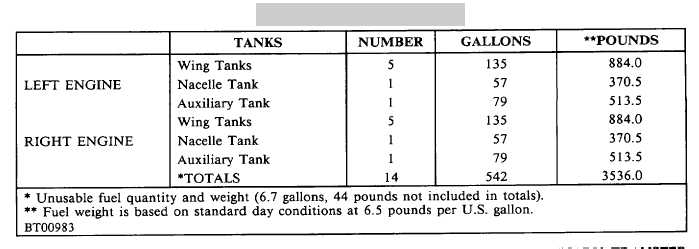TM 55-1510-219-10
by two 10-ampere circuit breakers placarded STANDBY
PUMP #1 or #2, located on the overhead circuit breaker
panel (fig. 2-26), and four 5ampere circuit breakers (2
each in parallel) on the hot battery bus.
c.
Fuel Transfer Pumps. The auxiliary tank fuel
transfer system automatically transfers the fuel from the
auxiliary tank to the nacelle tank without pilot action.
Motive flow to a jet pump mounted in the auxiliary tank
sump is obtained from the engine fuel plumbing system
downstream from the engine driven boost pump and
routed through the transfer control motive flow valve.
The motive flow valve is energized to the open position
by the control system to transfer auxiliary fuel to the
nacelle tank to be consumed by the engine during the
initial portion of the flight. When an engine is started,
pressure at the engine driven boost pump closes a
pressure switch which, after a 30 to 50 second time delay
to avoid depletion of fuel pressure during starting,
energizes the motive flow valve. When auxiliary fuel is
depleted, a low level float switch de-energizes the motive
flow valve after a 30 to 60 second time delay provided to
prevent cycling of the motive flow valve due to sloshing
fuel. In the event of a failure of the motive flow valve or
the associated control circuitry, the loss of motive flow
pressure when there is still fuel remaining in the auxiliary
fuel tank is sensed by a pressure switch and float switch,
respectively, which illuminates a light placarded #1 or #2
NO FUEL XFR on the annunciator panel. During engine
start, the pilot should note that the NO FUEL XFR lights
extinguish 30 to 50 seconds after engine start. The NO
FUEL XFR lights will not illuminate if auxiliary tanks are
empty. A manual override is incorporated as a backup for
the automatic transfer system. This is initiated by placing
the AUX TRANSFER switch, located on the fuel
management panel (fig. 2-13) to the OVERRIDE position.
This will energize the transfer control motive flow valve.
The transfer systems are protected by 5-ampere circuit
breakers placarded AUXILIARY TRANSIEK #1 or #2,
located on the overhead circuit breaker panel (fig. 2-26).
NOTE
In turbulence or during maneuvers,
the NO FUEL XFR lights may
momentarily illuminate after the
auxiliary
fuel
has
completed
transfer.
d.
Fuel Gaging System. The total fuel quantity in
the left or right main system or left or right auxiliary tank
is measured by a capacitance type fuel gaging system.
Two fuel gages, one for the left and one for the right fuel
system, read fuel quantity in pounds. Refer to Section XII
for fuel capacities and weights. A maximum of 3% error
may be encountered in each system. However, the
system is compensated for fuel density changes due to
temperature excursions. In addition to the fuel gages,
yellow No. 1 or No. 2 NAC LOW lights on the caution/
advisory annunciator panel illuminate when there is
approximately 20 minutes of fuel per engine remaining
(on standard day, at Sea Level, Maximum Cruise Power
consumption rate). The fuel gaging system is protected
by individual 5 ampere circuit breakers placarded QTY
IND and QTY WARN #1 or #2, located on the overhead
circuit breaker panel (fig. 226). A mechanical spiral float
gage (fig. 2-13) is installed in the auxiliary fuel tank to
provide an indication of fuel level when servicing the tank.
The gage is installed on the auxiliary fuel tank cover,
adjacent to the filler neck. A small sight window in the
upper wing skin permits observation of the gage.
e.
Fuel Management Panel. The fuel management
panel (fig. 2-13) is located on the cockpit overhead
between the pilot and copilot. It contains the fuel gages,
standby fuel pump switches, the crossfeed valve switch
and a fuel gaging system control switch and transfer
control
switches
are
also
installed.
2-29
Table 2-2. Fuel Quantity Data


